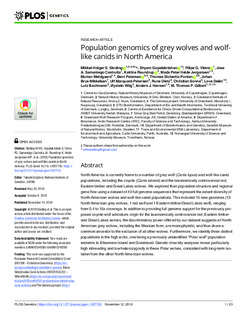| dc.contributor.author | Sinding, Mikkel Holger Strander | |
| dc.contributor.author | Gopalakrishnan, Shyam | |
| dc.contributor.author | Vieira, Filipe G. | |
| dc.contributor.author | Samaniego, Jose A | |
| dc.contributor.author | Raundrup, Katrine | |
| dc.contributor.author | Heide Jørgensen, Mads Peter | |
| dc.contributor.author | Meldgaard, Morten | |
| dc.contributor.author | Petersen, Bent | |
| dc.contributor.author | Sicheritz-Ponten, Thomas | |
| dc.contributor.author | Mikkelsen, Johan Brus | |
| dc.contributor.author | Marquard-Petersen, Ulf | |
| dc.contributor.author | Dietz, Rune | |
| dc.contributor.author | Sonne, Christian | |
| dc.contributor.author | Dalén, Love | |
| dc.contributor.author | Bachmann, Lutz | |
| dc.contributor.author | Wiig, Øystein | |
| dc.contributor.author | Hansen, Anders J. | |
| dc.contributor.author | Gilbert, Marcus Thomas Pius | |
| dc.date.accessioned | 2019-04-02T12:31:25Z | |
| dc.date.available | 2019-04-02T12:31:25Z | |
| dc.date.created | 2018-10-29T17:59:59Z | |
| dc.date.issued | 2018 | |
| dc.identifier.citation | PLoS Genetics. 2018, 14:e1007745 (11), . | nb_NO |
| dc.identifier.issn | 1553-7390 | |
| dc.identifier.uri | http://hdl.handle.net/11250/2592951 | |
| dc.description.abstract | North America is currently home to a number of grey wolf (Canis lupus) and wolf-like canid populations, including the coyote (Canis latrans) and the taxonomically controversial red, Eastern timber and Great Lakes wolves. We explored their population structure and regional gene flow using a dataset of 40 full genome sequences that represent the extant diversity of North American wolves and wolf-like canid populations. This included 15 new genomes (13 North American grey wolves, 1 red wolf and 1 Eastern timber/Great Lakes wolf), ranging from 0.4 to 15x coverage. In addition to providing full genome support for the previously proposed coyote-wolf admixture origin for the taxonomically controversial red, Eastern timber and Great Lakes wolves, the discriminatory power offered by our dataset suggests all North American grey wolves, including the Mexican form, are monophyletic, and thus share a common ancestor to the exclusion of all other wolves. Furthermore, we identify three distinct populations in the high arctic, one being a previously unidentified “Polar wolf” population endemic to Ellesmere Island and Greenland. Genetic diversity analyses reveal particularly high inbreeding and low heterozygosity in these Polar wolves, consistent with long-term isolation from the other North American wolves. | nb_NO |
| dc.language.iso | eng | nb_NO |
| dc.publisher | Public Library of Science | nb_NO |
| dc.rights | Navngivelse 4.0 Internasjonal | * |
| dc.rights.uri | http://creativecommons.org/licenses/by/4.0/deed.no | * |
| dc.title | Population genomics of grey wolves and wolf-like canids in North America | nb_NO |
| dc.type | Journal article | nb_NO |
| dc.type | Peer reviewed | nb_NO |
| dc.description.version | publishedVersion | nb_NO |
| dc.source.pagenumber | 23 | nb_NO |
| dc.source.volume | 14:e1007745 | nb_NO |
| dc.source.journal | PLoS Genetics | nb_NO |
| dc.source.issue | 11 | nb_NO |
| dc.identifier.doi | 10.1371/journal.pgen.1007745 | |
| dc.identifier.cristin | 1624637 | |
| dc.description.localcode | © 2018 Sinding et al. This is an open access article distributed under the terms of the Creative Commons Attribution License, which permits unrestricted use, distribution, and reproduction in any medium, provided the original author and source are credited. | nb_NO |
| cristin.unitcode | 194,31,10,0 | |
| cristin.unitname | Institutt for naturhistorie | |
| cristin.ispublished | true | |
| cristin.fulltext | original | |
| cristin.qualitycode | 2 | |

